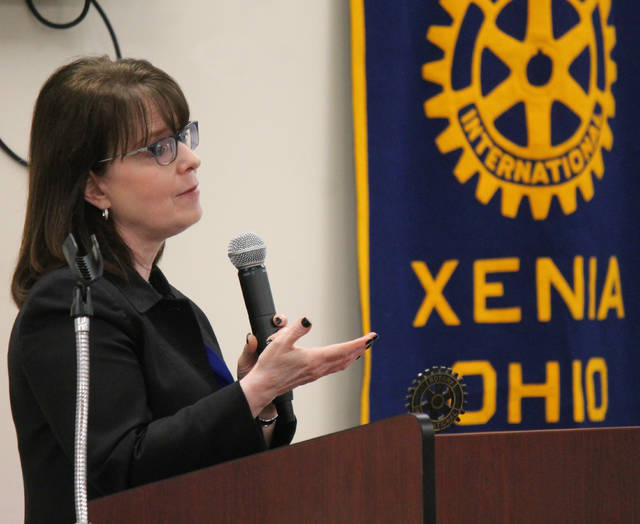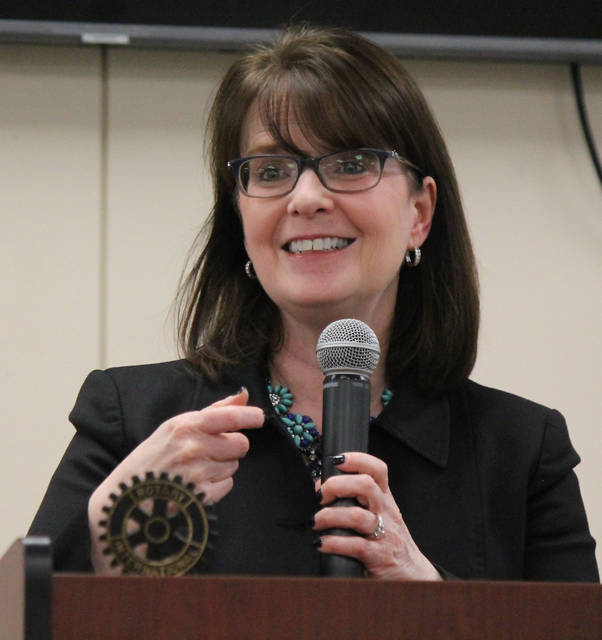

XENIA — Marbles.
That’s how the Ohio Supreme Court decides who gets to write an opinion, Justice Judith French revealed during a trip to the county seat last month.
Xenia Rotary was just one stop on the justice’s 88-county trek. She’s on her fifth tour around the state, traveling 1,000 miles a week to make it to each county again.
“I serve all 88 counties so it’s important for me to get to all 88 … to really see what’s happening in the state, where the progress is, where the challenges are,” French said Nov. 26 at the REACH Center. “Part of our job is deciding what cases to take into the court — to decide what we want to decide. So the more I’m out talking to people, I think the better able I am to make that kind of judgment about what issues I’m hearing about, what business leaders and public defenders and prosecutors are dealing with.”
French, who became a justice in 2013, gave rotarians a behind-the-scenes look into what it’s like to serve on the state’s highest court — from casting votes to reading briefs to selecting a marble.
The Ohio Supreme Court decides on cases that have gone through the trial courts and the appeals court.
“The constitution says we have jurisdiction to take in questions of public or general interest. What that means to me — I want to know who cares about this case. If it’s a case that just involves two parties … that’s not the kind of case we’re likely to take in,” French said. “That’s the decision that I’m making — what’s the impact of this case, does it involve a constitutional question or question of state law.”
Four out of the seven justices must agree that the case is a question they want to decide. French said the court gets about 1,300 of those requests every year and accepts around 70.
“We do get cases from other directions — death penalty cases, cases involving utilities, tax cases, and discipline of judges or lawyers,” French said. “All together that adds up to about 2,000 votes that I’m casting every year to decide what cases to bring in, and make decisions about those cases as well.”
Although often on the road, French wastes no time — she reads.
If what she usually reads in a 2- to 3-week span was printed out on paper, it would take up about five feet.
“It’s about — me — in reading,” French joked. “But most of what I read is electronic … Zach [Kent, my political director] is driving these days. That means I can have a hot spot and a laptop … to get through those briefs and motions.”
After the reading is done, it’s time for oral argument. The justices gather in the “robing room” before filing into the courtroom. While Chief Justice Maureen O’Connor sits in the center of the bench, the other six in order of seniority.
“Now I’m number three, which means I sit near the center, which also means lawyers look at me and make eye contact,” French said.
Lawyers on each side are allotted 15 minutes to argue. Then the justices and the official court reporter go into “conference.”
“The chief justice is seated at the head of the table and the rest of us are around the table in order. The rule is that you speak in order of seniority and you speak without interruption the first time around … When that’s done we open it up,” French said. “We all bring our own personality to that debate. It’s professional and it’s cordial but it’s pretty spirited. At least four of us thought this was a question important enough to bring in for us to decide.”
The vote is done in reverse order with the junior justice going first. Sometimes the chief justice breaks a tie.
But only one, ultimately, must write the opinion.
“In the U.S. Supreme Court, it’s the chief justice who gets to decide who will write the opinion,” French said. “In Ohio, we don’t do it that way. We decide by marbles.”
Each of the marbles is numbered.
“Mine happens to be number 1,” French said. “If I voted with the majority then my marble goes into a little leather bottle and one of the justices shakes up the bottle and puts one in the hand of another justice. If it’s your marble then you have to write the opinion.”
French said they “keep score,” so that if one justice has written one more opinion than everybody else, their marble doesn’t go into the bottle. Also — there are no trades.
“So the next time you hear my name on the radio about some controversial opinion that I wrote,” French began, “it’s not because I wanted to write that opinion. It’s because my marble came out of the bottle — marble number one.”



